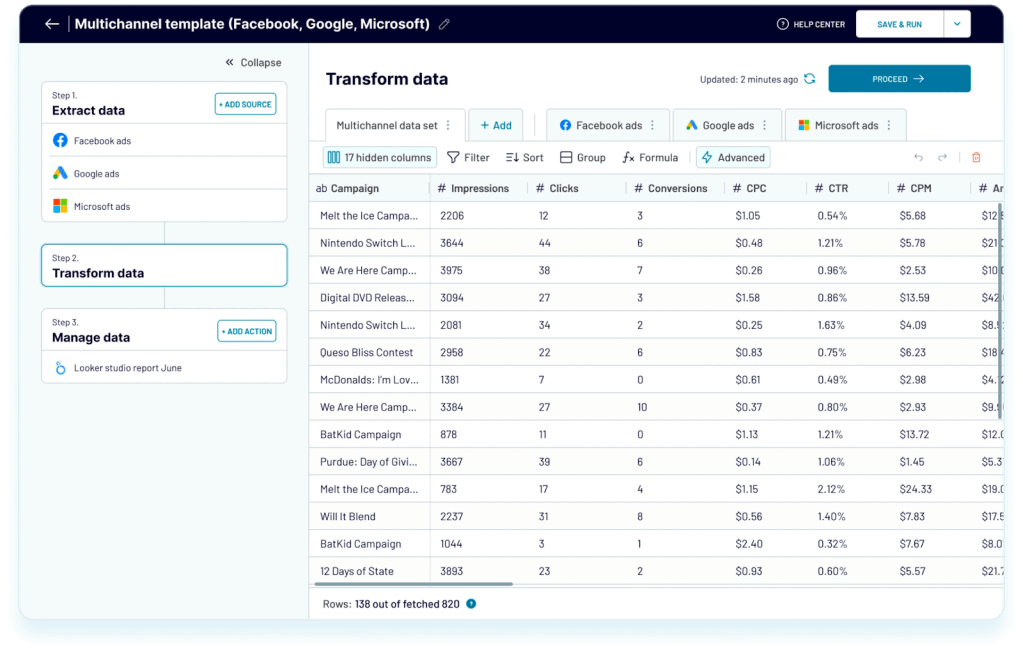Looking to become a marketing analyst? This guide is exactly what you need to get started as it covers everything you need to know about:
- The role’s responsibilities.
- How to perform specific day-to-day tasks in this role.
- Education and skills you need.
- Salary and career paths.
What is a marketing analyst?
A marketing analyst, also referred to as a marketing data analyst, is the person inside the marketing team responsible for collecting and analyzing customer, market, and business data.
The insights the marketing data analyst collects are the backbone of successful marketing strategies and campaigns. They drive and inform the team’s performance and decisions.
Let’s look at the role’s main responsibilities.
Overview of the role of a marketing analyst in 2023
While the role of a marketing analyst can vary across industries and business needs, there are some main responsibilities you’d be facing in this position.
We’ll cover them briefly below, and then we’ll get into more detail as we explore how these apply to day-to-day tasks.
Main marketing analyst responsibilities
We already mentioned that a marketing analyst works with data, but what does this really mean? Some of the top responsibilities include, but are not limited to:
- Data collection and sorting: Extract data from multiple sources, then clean and prepare it for analysis.
- Data analysis: Understand trends and generate insights by using software built for big data analysis or by writing SQL queries and Python scripting for more custom and in-depth analysis.
- A/B and multivariate testing: Build hypotheses based on data and set up experiments to improve desired business metrics.
- Data visualization: Group and manipulate data for easier visualization using graphs and charts for marketing team alignment.
- Reporting: Build dashboards to visualize specific marketing campaign metrics, test results, or overall team progress for better stakeholder alignment.
- Defining target audiences: Analyze data from surveys and other market analysis variables to understand who your user persona is.
What does a marketing analyst do?: Day-to-day tasks
Now that we have a good overview of the main responsibilities, let’s look at what a day in the life of a marketing analyst could look like and what tools they use to perform specific tasks.
Gather data from multiple sources
The main thing a marketing analyst needs to have in place is data collection. Without the right data, there’s nothing to analyze. The list of sources will vary based on your team’s tech stack and could include:
- Different marketing analytics tools like Google Analytics.
- Marketing campaign tools like MailChimp.
- Customer relationship management tools (CRM) like Hubspot.
- E-commerce analytics from tools like Shopify.
- Different spreadsheets or Excel files.
- Consumer behavior or market trends reports.
Do you actually need multiple sources?
How many sources you need to collect data from will depend on what insights you are trying to get. The more data you have connected together, the more granular and specific your reports will get.
For example, your marketing team needs to understand which acquisition channels have the best ROI. You could probably look at your campaign data for your search ads and organic traffic inside Google Analytics, then check how your social media ads are performing inside each tool and so on. This will give you siloed information.
If you want one report with all data so your team can make smarter decisions on budget allocation for lowering acquisition costs, extracting and merging all the data from relevant sources will make that possible.
How to extract data from multiple sources for better data analysis
There’s both an easy and complex option, a more expensive or cheaper one, and the list can go further. Making a decision on which works best for you will be based on multiple factors:
- Skills level: How well do you understand a specific process?
- Time constraints: How much time do you have to implement a process?
- Budget: Can you afford to purchase a tool for the task or outsource it?
Let’s first assume you are highly skilled in using Python and have written data mining scripts before. Being familiar with this, you might want to go the manual route and set everything up yourself. On top of this, scaling your Python solution will require a budget for a serverless solution to run your code on schedule.
You’ll have to repeat the process every time you need to add data sources or update existing data and it could end up occupying all your time. Not to mention it can rapidly become expensive, depending on how many processes you need to run and how big your database is.
A simpler and faster way would be to use marketing reporting tools to automate the entire process.
We’ll illustrate how this works using Coupler.io. It’s a marketing reporting automation solution that automates data exports from different sources to spreadsheets (Google Sheets, Excel), data warehouses (Power BI, Redshift, etc.), and BI tools (Looker Studio, Power BI, etc.).
Select the source and destination apps in the form below. You’ll be prompted to create an account at Coupler.io for free.
You are now ready to connect the data source to Coupler.io. Click Connect and follow the quick authorization instructions. Once the connection is set, you can choose which data you want to export.

When you are done with setting the data you want to extract, you can either continue and add more sources or move to the next step and Transform your data. This is all about cleaning and sorting it so it’s easier to analyze. Click Transform data to continue if you are happy with one source.
Manage columns, filter, sort, or manipulate data using formulas. You can skip this step and always come back to edit it when needed. Click Proceed to move to the Manage stage and export the data.

Set the destination where you want your data to be exported for analysis. You must connect the source by going through a quick authorization wizard. Change the destination by clicking on Change or proceed and set up the connection by clicking Connect.

After connecting to the destination source and setting up the location, you are good to go. You can also enable automatic data refresh at this step if you need a constant data flow.

That’s all you need to do and your data will be exported automatically on a schedule.
Coupler.io pricing starts at $49/mo when paid annually, and it gives you access to set up unlimited integrations with specific settings to export data from 50+ data sources to a destination. You can sign up for a free version.
Clean and sort data for analysis
When all your data is in one place, the next task you need to handle is to make sure you can use it. This is where the cleaning and sorting process takes place.
Similar to the data extraction process we discussed above, this too can be done in a simple or complex way.
Let’s say you exported all your data to a data warehouse like BigQuery for storage and analysis. You can use SQL queries to start merging data from multiple tables, sort it, and clean it.
You could also achieve this with a tool, and better yet, do it while you are exporting the data. This way, when your data reaches the destination, it is already cleaned and sorted.
Coupler.io can help with this, too. You can clean, sort, and transform your data using a data preview table inside Coupler.io’s Importer interface while you are setting up your data export (check the steps in the section above for more details on where to find this).

Analyze marketing data
Once your data is exported, merged, cleaned, and sorted, you are ready to analyze and visualize it. We’ll first cover how to analyze you data.
There are different methods and tools for doing this. Here are the main ones you might use as a marketing analyst:
- IBM SPSS statistics tool for statistical analysis: This is a qualitative and qualitative data analysis tool mostly used to analyze large and complex data sets and perform advanced statistical analysis like understanding market conditions.
- Structured Query Language (SQL) or Pandas library to analyze data: This is a code-based solution to manage data inside a database. You can use this for analyzing data across multiple BigQuery tables.
- Power BI, Looker Studio, and other BI tools for data exploration: These tools are useful for exploring your data, understanding future trends based on current data, and deriving valuable insights.
The right tool is always going to depend on what you need to analyze, how much data you are looking at, and the skills you have.
Measuring performance and reporting
Similar to analyzing data, when it comes to reporting, there is also a set of tools you can use for user-friendly marketing data visualization:
- Powerpoint for simple, non-recurring performance reporting: Use this for building a quick marketing deck to present to shareholders and investors. Alternatively, you can export a PDF of specific pages in your Looker Studio reports.
- Business intelligence tools like Microsoft Power BI or Tableau for data visualization: Use this to visualize large data sets using graphs and charts for easier interpretation. BI tools are also used for business administration data visualization, making this a great tool for marketing reporting to top-level stakeholders.
- Dashboard tools like Tableau, Power BI, or Looker Studio: Great for building quick data visualization dashboards from scratch or using predefined templates. This should be the way to go if you are looking to analyze main marketing campaign data in one view.
- Google Sheets reports: Beginner-friendly solution for generating table reports and charts that can come in handy.
Here’s what a Google Ads dashboard might look like in Looker Studio. Of course, you could add different sources on top of this and create more complex marketing reporting dashboards or web analytics dashboards. You can get this template for free here. All you need to do is connect your data.

Informing marketing strategies and decisions
We’ve covered a lot on marketing data analysis as that’s the main part of the job of a marketing analyst. Apart from those ongoing tasks, a marketing analyst will also use the data to:
- Create hypotheses based on data and set experiments to validate them. For example, testing if changing the subject line in the first email of your lead nurturing campaign will improve the open rate and call to action conversion rate.
- Continuously iterating and optimizing hypotheses based on results.
- Informing and building user personas based on data.
Now that you understand what it means to be a marketing analyst, let’s look at what it takes to become one. In the next section, we’ll cover the skills you need and the education that can help you get there.
Digital marketing analyst skills you need
First, let’s look at the skills needed for this role. We’ve divided them into three main categories:
- Soft skills: These cover basic skills that will help you in any analytical role.
- Technical skills: These cover specific skills and technologies you must understand to succeed as a marketing analyst.
- Marketing skills: These cover industry knowledge you must acquire since this is a role inside the marketing department.
Soft skills
| Soft skill | What it means |
|---|---|
| Project Management | Understand how large projects are structured and managed. |
| Problem solving | Ability to identify problems and generate potential solutions. |
| Critical Thinking | Ability to understand complex problems and form an objective judgment. |
| Data-driven | Ability to base decisions on relevant data. |
| Communication skills | Being able to clearly communicate complex topics in simple ways. |
| Organization skills | Managing multiple tasks in a timely manner. |
| Presentation skills | Being able to present data in a visually pleasing way. |
| Attention to detail | Easily spot mistakes or inaccuracies. |
Technical skill set
| Technical skill | Tools |
|---|---|
| Data analysis and analytical skills | SQL, Python, BigQuery, Redshift, SPSS for statistical analysis. |
| Web analytics tools | Google Analytics, Amplitude. |
| Data collection | Scripting or using marketing data integration tools (Coupler.io). |
| Data visualization | Tableau, Looker Studio, Power BI. |
Marketing skill set
| Marketing skill | What it means |
|---|---|
| Marketing pricing | Understanding how different pricing models work. |
| Sales analysis | Being familiar with main sales and marketing KPIs. |
| Social media | Understanding main platforms and important KPIs. |
| Target audience | Understanding what a user persona is and the importance of segmentation. |
| Marketing strategy | Understanding the concepts of strategy and common marketing tactics for specific channels. |
How to become a marketing analyst
There are multiple ways for marketing professionals to start and grow as digital marketing analysts.
Here are the top ones you should be looking into.
Preferred education to have
- Mathematics
- Data analytics
- Marketing
- Computer science
- Psychology
- Business
Get a professional certification
As the field of marketing is growing quite fast, so are the number of tools and data you can collect and analyze. While a bachelor’s or a master’s degree can give you the basics, oftentimes, a professional certification can give you a boost and improve your skills in a specific niche.
Available certifications range from simple to complex, free or expensive, and cover a plethora of topics. From using specific tools to learning SQL or understanding a specific field or industry, here are some useful certifications:
- Google certifications on Coursera: Google Data Analytics Professional Certificate (FREE).
- Microsoft: Microsoft Certified: Power BI Data Analyst.
- Udemy: Marketing Analytics: The Full Marketing Research Masterclass.
- Coursera: Python for Data analysis.
- Coursera: Introduction to Relational Databases and SQL.
- Coursera: Analyze Digital Marketing Spend in Tableau.
Gain work experience
Continuous education is fundamental, but pairing it with real work experience is the way to grow.
Depending on your years of experience and skills you’ve built in that time, you can progress through different seniority levels.
At the time of writing this article, there were 101 available internship and entry-level positions and 455 associate to executive positions for a marketing analyst in the United States, listed on LinkedIn. Opportunities go up from there.
You could also use other job search engines like Indeed, Monster, Getwork, or FlexJobs to find open positions.
Marketing data analyst salary
Data from the US Bureau of Labor Statistics (BLS) 2022 reports that the average marketing analyst salary across the US was:
- $79,880 for Management, Scientific, and Technical Consulting Services.
- $74,310 for Advertising, Public Relations and Related Services.
- $107,000 for Software Publishers.
Similarly, Glassdoor’s 2023 report gives an estimated total pay of $69,943 for a marketing analyst position in the US, with an average salary of $65,240.

Marketing analyst career path
As we’ve seen, the marketing analyst role can be a varied role with a lot of growth potential.
As with any job, there are quite a few higher positions that you can aim for as you accumulate expertise and experience through learning new tools and approaches.
You can be looking at a vertical growth path and become a senior marketing analyst, analytics marketing manager, director of marketing analytics, or even VP of marketing analytics.
Since the role can become a bit repetitive as a marketing analyst spends most of the day looking at large data sets, there is also a horizontal career path that involves switching analytical roles. Here, you could be looking at becoming a market research analyst, data analyst, business analyst, or financial analyst.
Marketing analyst job description
We’ve already covered the marketing analyst’s responsibilities and what daily activities look like for a general position.
Here’s a general example from a GlassDoor job that sums up the main job responsibilities, skills, and education required for the position.
Marketing Analyst Job Description TemplateJob OverviewCome work at Example Co., a leading firm in our industry in the metro area. We’re pleased to have a 4.0 Glassdoor rating. We are looking to hire an experienced Marketing Analyst to help us keep growing. If you’re hard-working and dedicated, Example Co. is an ideal place to get ahead. Apply today! Responsibilities for Marketing Analyst
Qualifications for Marketing Analyst
|

FAQ
Marketing analyst vs. market research analyst
A marketing analyst is often confused with a market research analyst since the roles have overlapping responsibilities. The main difference between the two is that a marketing analyst focuses on business growth by analyzing and improving marketing campaigns (targeted email campaigns, ads, etc.), while a marketing research analyst focuses on external market data for research and informing strategic data-driven marketing decisions.
Marketing analyst vs. data analyst
A data analyst works with different data across departments. This could be finance data, product data, government data, etc. In comparison, a marketing analyst is focused on analyzing marketing data from campaigns across the entire marketing department.
Marketing analyst vs. business analyst
The main difference between a marketing analyst and a business analyst is the main objective of the role. A marketing analyst looks at data with a goal to measure digital marketing performance and improve marketing efforts of bringing products and services to market. A business analyst is focused on business data with the purpose of understanding and improving business performance.
Marketing analyst vs. financial analyst
A financial analyst is similar to a business analyst as they both work with financial data. A marketing analyst looks at marketing and growth data, while a financial analyst is solely focused on analyzing revenue and investments.







